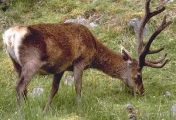 |
|
|
|
|
|
|
Large ungulate herbivores are usually very mobile. Their local impact is therefore dependent on when and how long they choose to feed in a particular area. Large mobile herbivores may reside in the alpine environment or change between alpine regions and the lowlands. In the Alps, ibex (Capra ibex) and chamois (Rupricapra rupricapra) use avalanche tracks, among other routes, as passageways between the uplands and the lowlands. They are able to follow the phenological changes of food quantity and quality with elevation. In addition to removing plant material and returning the nutrients in dung and urine, large herbivores often have a severe impact by trampling. Herbivory and movement by large ungulates can severely enhance erosion, especially in habitats with unstable soils, or when the number of herbivores exceeds the long-term carrying capacity (as sometimes happens due to human impact). Unlike many alpine herbivores, whose populations are limited by plant productivity in the alpine zone, large migrating vertebrates may profit from food available in the lowlands, especially in winter. Thus, disproportionately large populations may affect the alpine vegetation in summer; alpine cattle grazing is the most extreme example of this phenomenon. |
|
1 - Capra ibex |
Ibex The habitat use of ibex changes seasonally, and is strongly affected by weather conditions. In contrast to many other ungulates, ibex often stay above the treeline in winter, but the animals are restricted to steep areas that do not accumulate much snow. In summer, their distribution with regard to elevation, aspect, and slope is closely linked to vegetation status, yet other factors like temperature, mineral requirements and avoidance of biting insects or humans also play a role in habitat selection. Ibex populations tend to use the same sites over many years, while apparently equivalent sites are either not used or are used to a much lesser extent; as a consequence, there may be over-utilization of some sites. |
|
2 - Cervus elaphus |
Red deer Red deer (Cervus elaphus) stay within the forest zone during winter, but use
alpine grasslands for summer pasturing. |
|
3 - Rangifer rangifer |
Reindeer Reindeer (Rangifer rangifer) are an important component of arctic-alpine ecosystems. They follow large migration routes and in any particular locality they are only transient. In winter, lichens make up a large fraction of their food, whereas, during summer, reindeer show a preference for plants and developmental stages with high protein content. This causes the herds to seek south-exposed slopes in spring to early summer while northern exposures are favoured in late summer to autumn. Herbs with tall, flower-bearing shoots appear to be especially sensitive to reindeer grazing because they become severely trampled as the animals forage for the most nutritious herbage. |
|
|
|
Are you finished with the pages dealing with invertebrates, small vertebrates and large vertebrates? Then you will be able to fill in the feature table of the various herbivores. |
29 August 2011 |
||
| |
||


